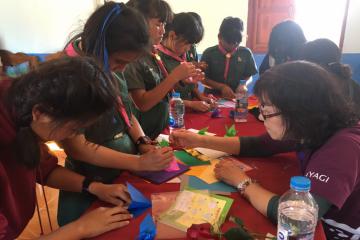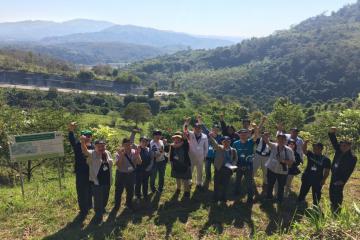
Feb 28, 2019
From February 5 to February 9, a group of OISCA supporters made an observation tour in Chiang Rai Prefecture, Northern Thailand where many minority tribal people live. The group comprised 17 persons including 14 OISCA supporters from Miyagi Prefecture and Fukushima Prefecture, and 2 OISCA staff and a volunteer, and visited various sites of the projects being implemented for the improvement of livelihood with the Japanese government grant assistance for NGO projects as well as tree planting sites of the Children’s Forest Program (CFP).
Prior to the start of the on-site tour, the visiting group got general briefings from the senior officials of OISCA Thailand at the hotel in Chiang Rai. Mr. Ari Choangulia, Chairman of OISCA Thailand, first welcomed the tour group and made a presentation on the current forest situation and OISCA activities in Northern Thailand. He said that the present forest cover rate in Thailand is about 37% as against 53.3% in 1961. The decline of the forest cover rate is due to slash-and-burn agriculture practiced by the migrant mountain tribes, illegal logging and forest fires frequently occurring during the dry season. In 2015, the Thai government banned open burning in the dry season which are susceptible to cause forest fires. He cited three areas: CFP, forest development projects and livelihood improvement projects through the Japanese grant assistance for NGO projects as the main activities of OISCA Thailand in the northern region. Afterwards, Mr. Tomoyuki Tanoi, OISCA Project Coordinator in Northern Thailand, explained the details of the projects now underway in the two villages the tour group visited.
The group first went to the mountainous tree planting site in Paabong Village with 558 residents located in the southwest of Chiang Rai and observed the livelihood improvement projects such as honey bee keeping, cultivation of wild plants, fish breeding (cat fish and tilapia) and making soaps with honey. The village residents carrying out the projects sell honey, soaps made with honey, and cultivated plants and fish in order to increase their income. The Japanese group experienced soap making and harvesting wild plants, and also tasted the tilapia cultivated in fish ponds which was served for lunch with the villagers.
In the afternoon, the OISCA tour members visited Paabong Thaaw Ken Ken Jan Elemenntary School, one of the CFP participating schools. The school has 102 pupils who all live at dormitories and 12 teachers. Together with school children, the tour members carried out weeding work and watering for the seedlings planted at the schoolyard. Several teams of children entertained the visiting group by performing traditional Thai dances. In return, the Japanese visitors taught the school children how to make ORIGAMI, Japanese art of paper-folding and played together by jumping rope. The children were very excited.
On the third day of the tour, the Japanese group visited Huaiyen Village, Chiang Khong located near the borders with Laos and Myanmar across the Mekhong River. At the meeting house, the village headman welcomed the group offering sweet oranges grown by the villagers. He said there are 543 residents, mostly minority tribes, in the community. With the Japanese government grant assistance, the villagers are engaged in such projects as tree planting over 12.8 hectares, making fire prevention belts, seedling making, honey bee keeping, pig farming, cattle breeding, and installation of water purification system. The villagers in charge of pig farmhouse and cattle breeding explained about the current progress of the projects. They have now 75 pigs and 12 heads of cattle. The tour members joined in making seedlings in pots together with the villagers. It was the first experience to most of the Japanese members and they found it quite hard to properly do it.
Afterwards, the tour group moved to another local school: Poong Nam Roen Elementary School with 277 pupils also participating in CFP. The Japanese visitors and school children carried out commemorative tree planting at the school yard. They planted such fruit trees as jackfruit, mango, longan, etc. They also made fire prevention belts at the planted site together and experienced fire fighting drill.
To conclude the on-site tour, the group visited on the fourth day the mountainous tree planting sites of Huaiyen Village. They observed the various forests developed over the years with the support of Japanese private corporations and organizations.
The tour participants unanimously agreed that the tour program was superbly arranged and it proved to be an excellent opportunity for them to better understand the actual situation of the field activities in Northern Thailand. A 22-years old lady participant from Miyagi Prefecture said: “It was my first overseas trip. Through visiting the various sites and meeting so many local people, I could broaden my mind.” Another lady participant from Fukushima Prefecture added: “I have already participated in a few other OISCA tours in the past. But this one was really informative because the program was full of substantial field activities. “
OISCA Miyagi Branch has been maintaining a close relationship with OISCA Thailand. Since five years ago, it has been actively supporting the activities of OISCA Thailand particularly in the northern areas of the country.
In June 2017, a 10-member delegation of OISCA Thailand led by the Chairman Mr. Ari Choanguila visited Japan mainly for the purpose of carrying out volunteer work in the maintenance of the Coastal Forest Restoration Project site in Natori City, Miyagi Prefecture and also for making presentation on their activities back home among the local government officials and residents in Natori.





